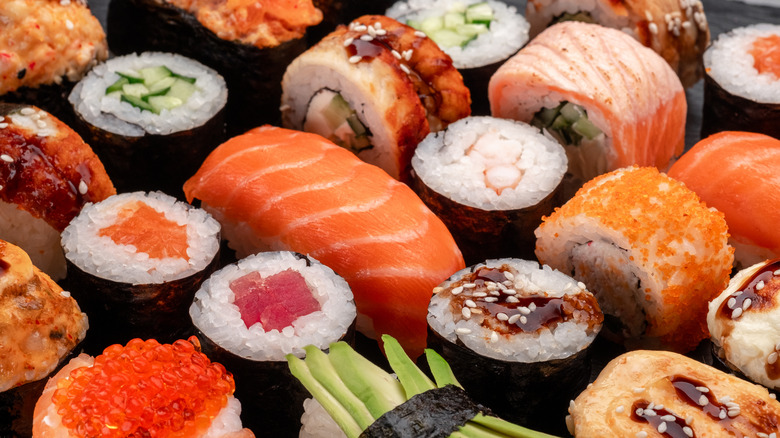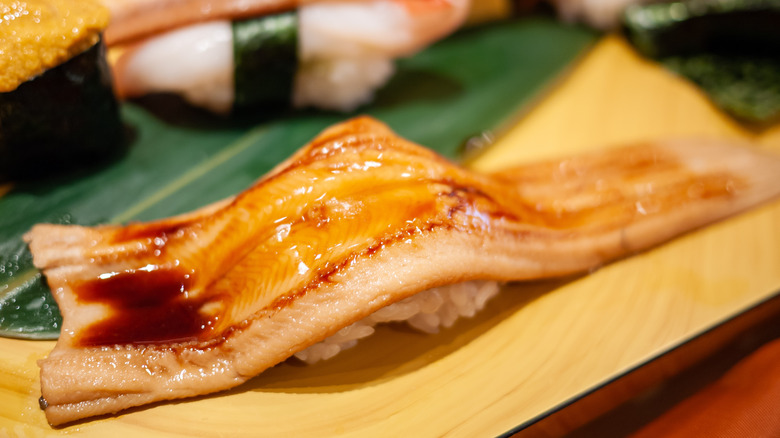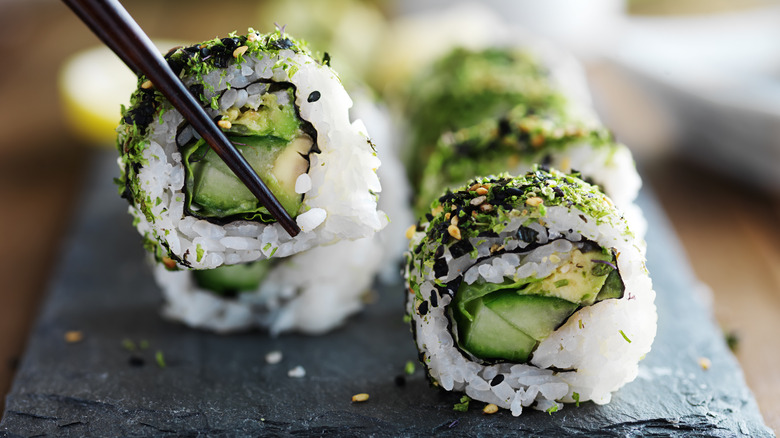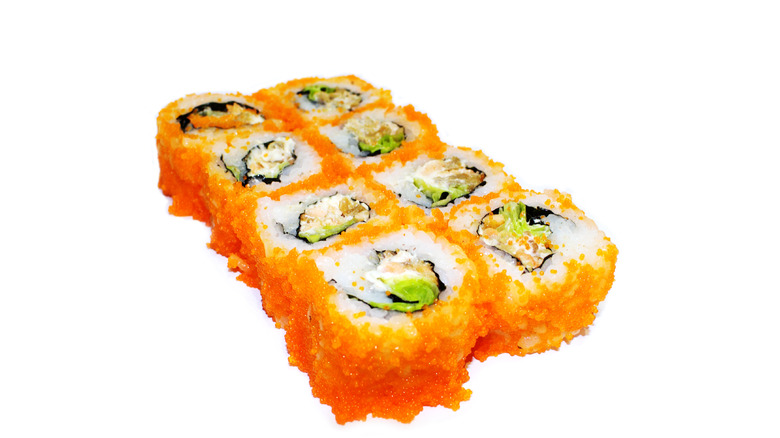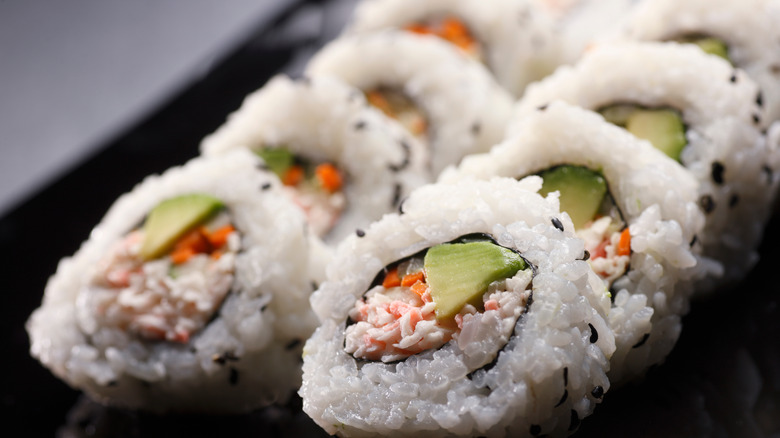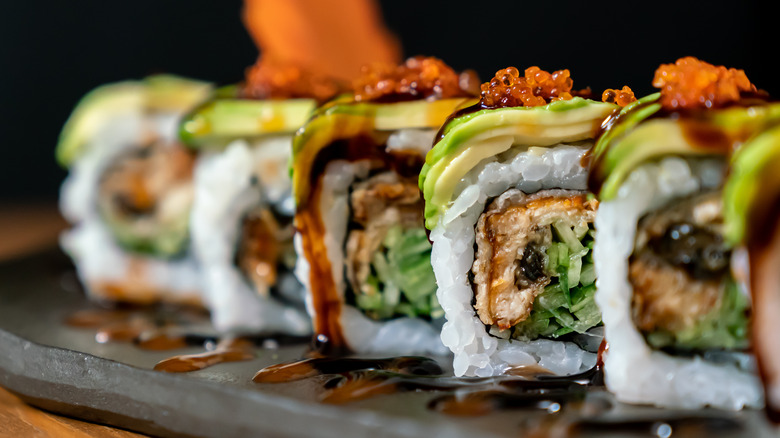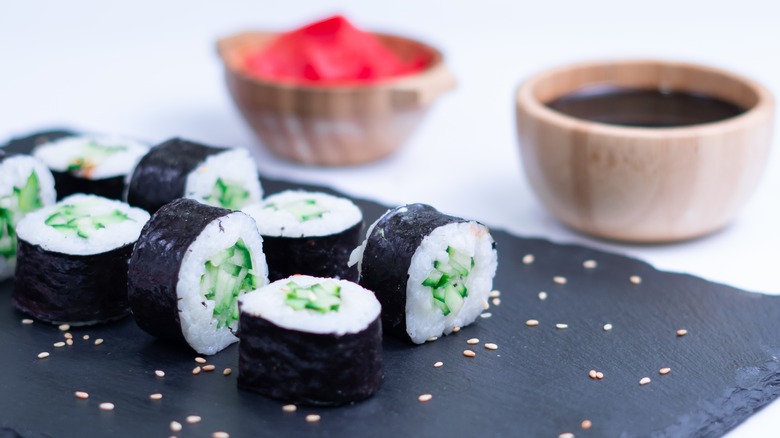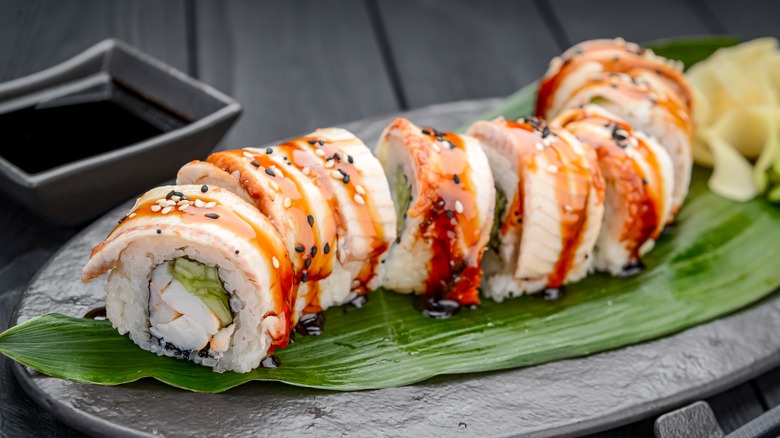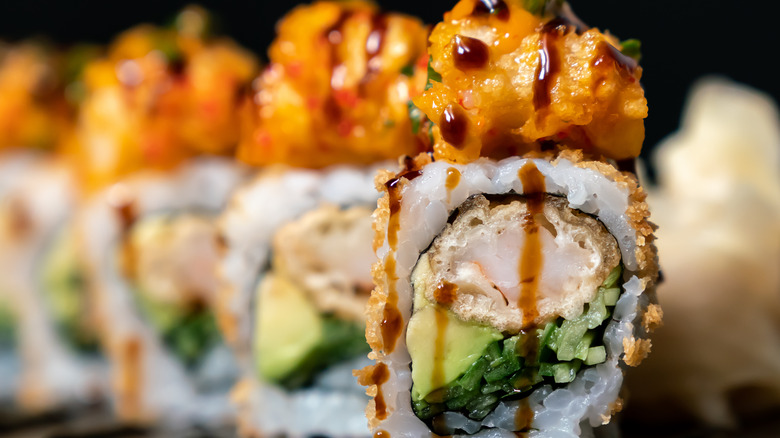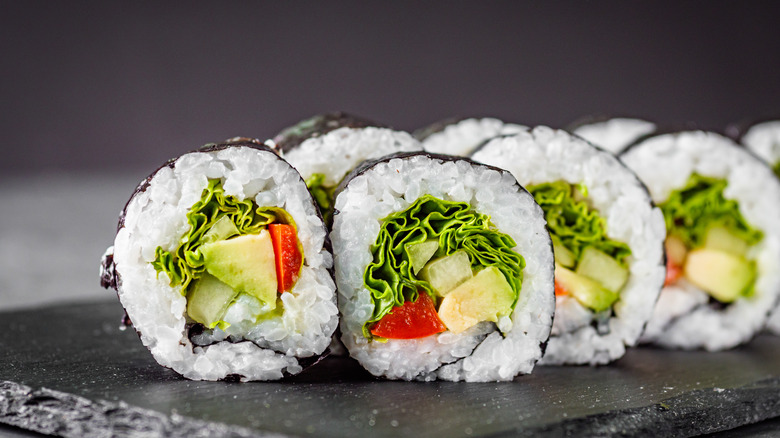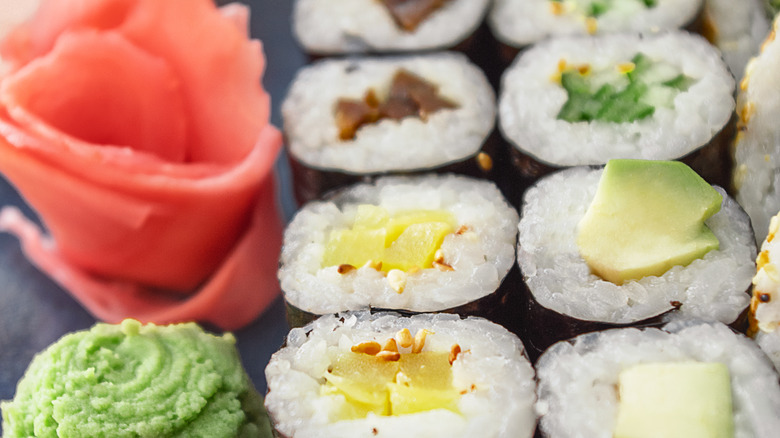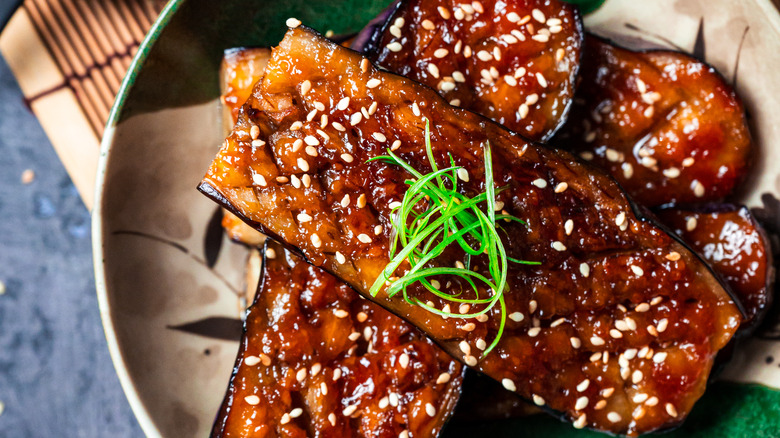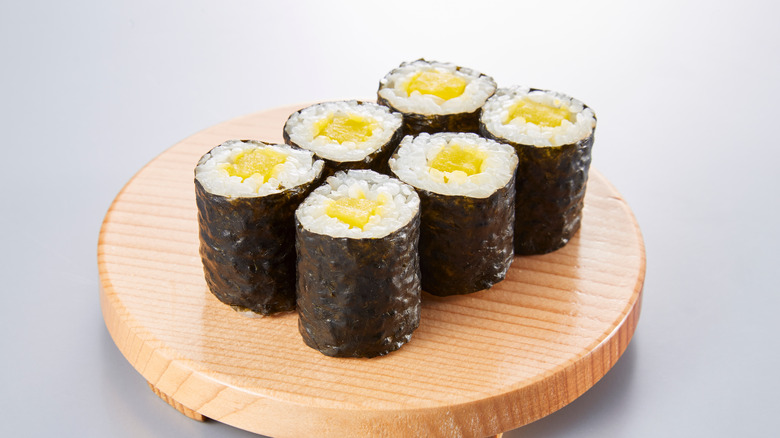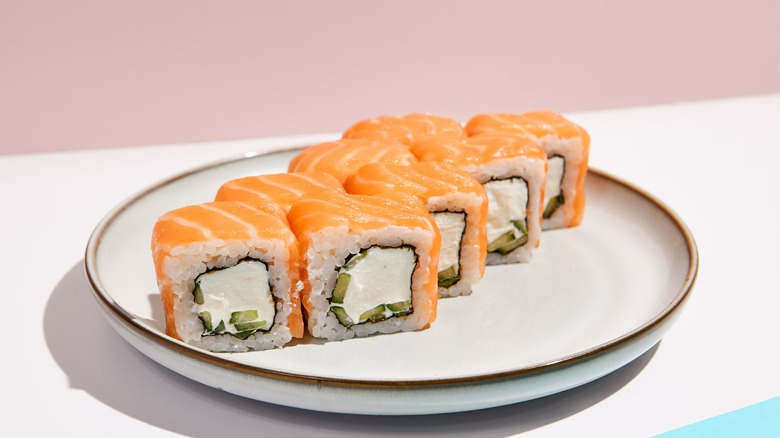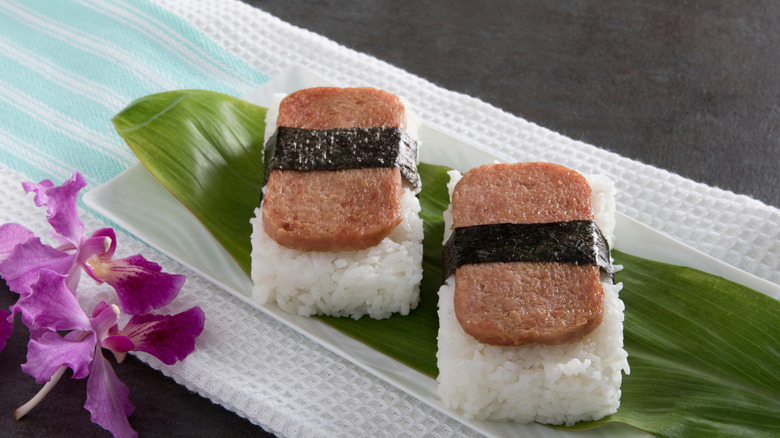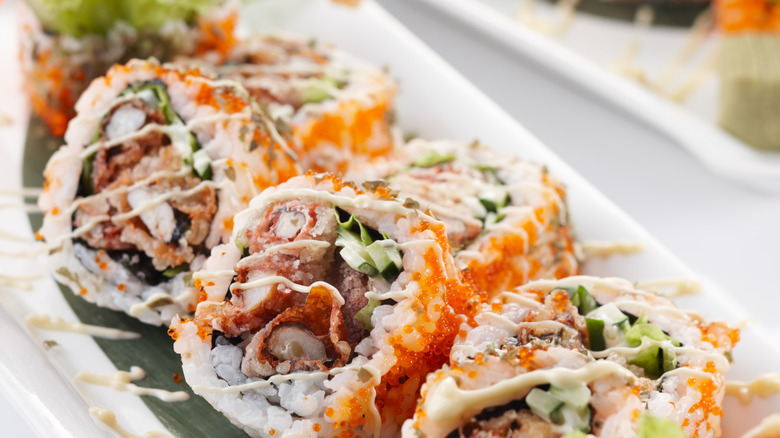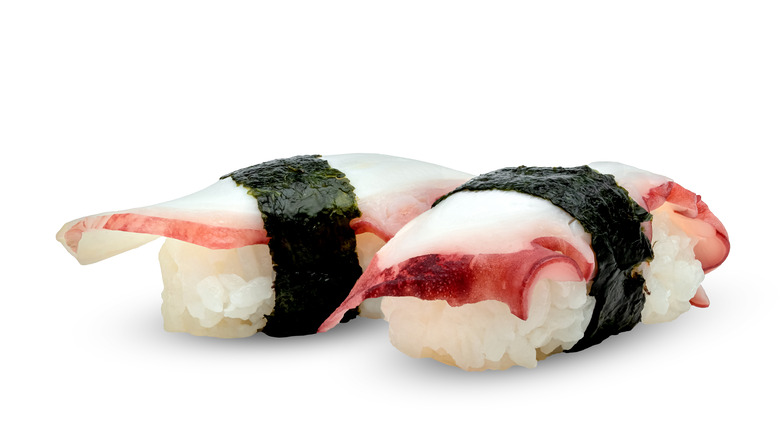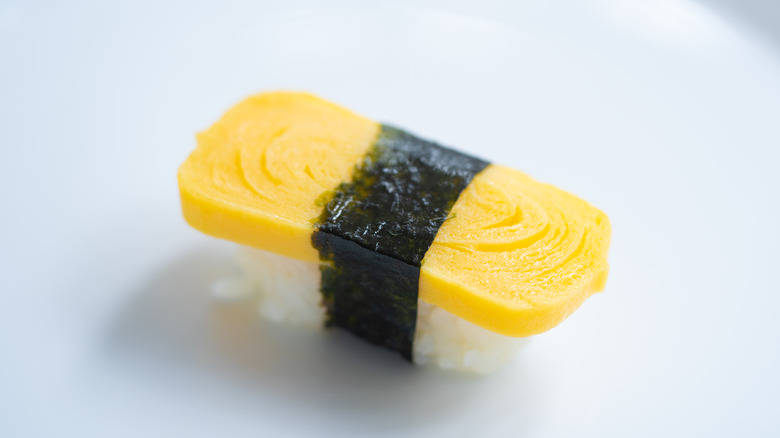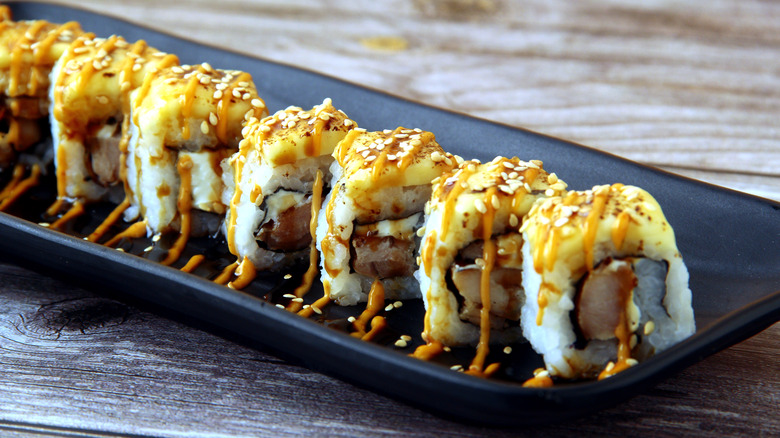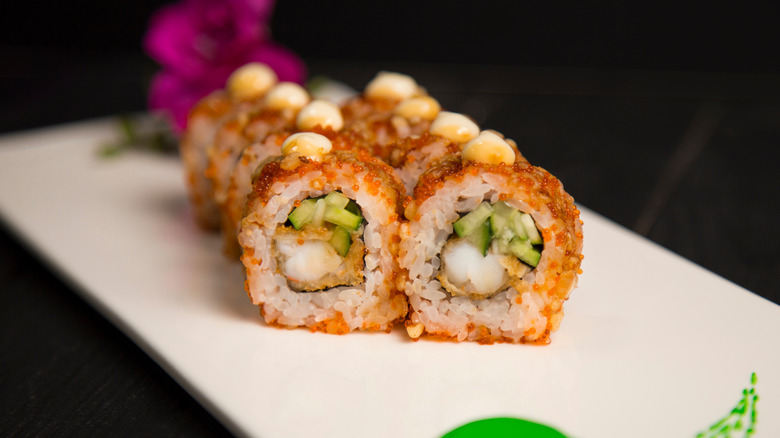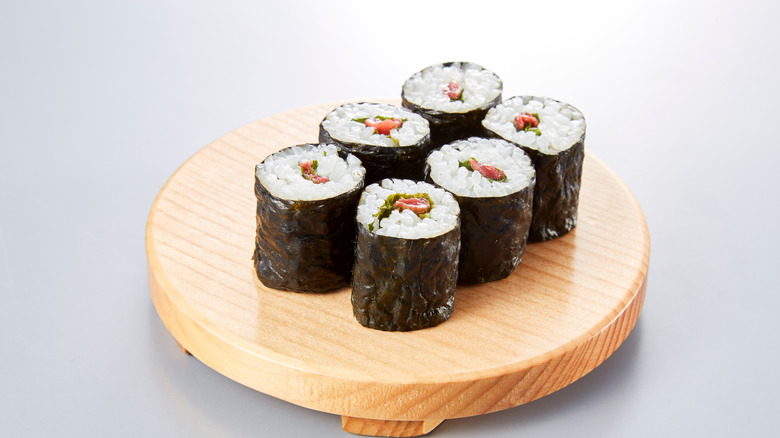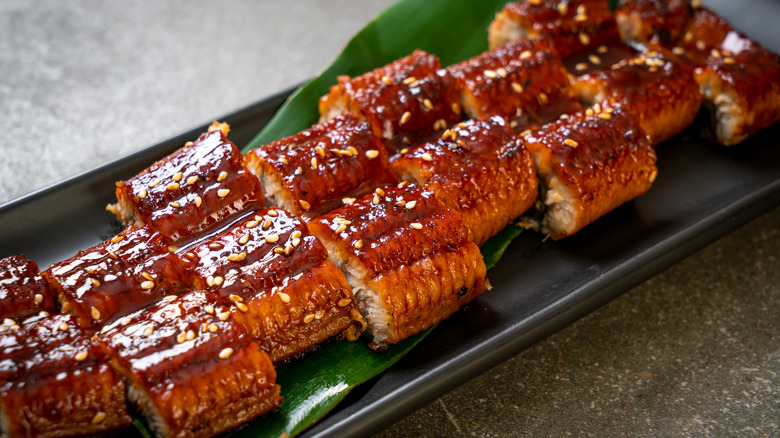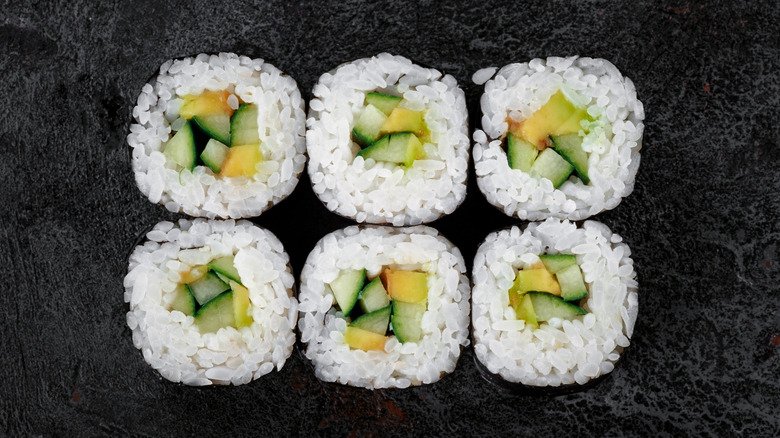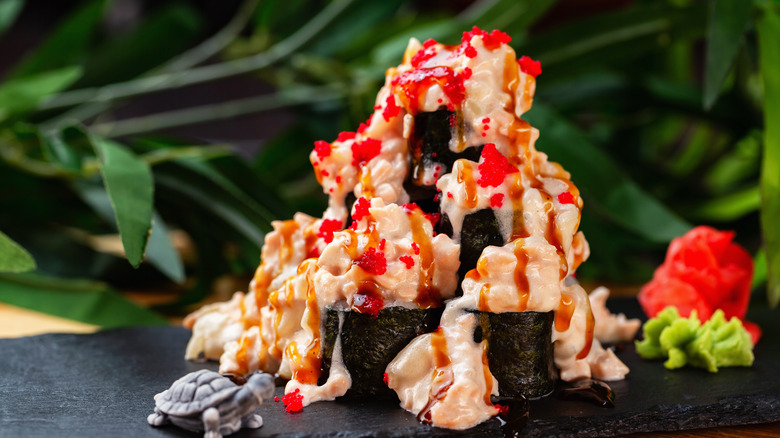23 Types Of Sushi Rolls For People Who Don't Like Raw Fish
Sushi has quickly grown from being a staple in Japanese cuisine to a highly popular beloved dish around the world. While sushi typically features a combination of raw fish rolled in sushi rice and nori seaweed, there are really no limits to the contents and style of sushi. In the U.S., sushi can be found at restaurants, grocery stores, and even gas stations. There are several renowned sushi restaurants in the U.S. that use high-quality fish in rolls and also pay homage to tradition while also providing new and interesting flavor mashups.
Sushi isn't everyone's cup of tea, and several people don't enjoy eating raw fish. There are plenty of reasons that people opt not to eat raw fish. Some are opposed to eating fish due to environmental reasons: Overfishing and polluted oceans have resulted in declining wildlife populations and degrading ocean ecosystems (via World Wildlife). Additionally, there are health risks associated with eating raw fish as it may contain dangerous levels of mercury and PCBs (via California Office of Environmental Health Hazard Assessment).
The rise of meat alternatives and plant-based diets has led to the creation of interesting types of sushi rolls for those who follow vegetarian or vegan diets. It's time for those averse to fish to rethink the definition of sushi. There are plenty of sushi varieties that contain raw fish whatsoever: Some contain cooked seafood, while others are plant-based, which gives you multiple different options to fulfill your sushi cravings.
Anago
Eel might not be for everyone, but sushi enthusiasts know that this slithering fish makes for a delicious bite. Anago is a saltwater eel, most typically stemming from the white-spotted conger eel (via Sushi Modern). It is often confused with unagi, which is a freshwater eel. Anago is never served raw, instead, it's simmered in its own concentrated broth. Simmering it in the reduced broth or tsume allows the meat to absorb all of the flavor while remaining sweet and tender. Anago may also be grilled.
Anago is a type of nigri sushi, which is a piece of fish over rice. Sometimes, eel sauce is added on top, but the seasoned rice offers a flavorful bite all on its own (via TasteAtlas). Anago may not be as popular as unagi, but it's worth ordering next time you see it on a sushi menu. Anago doesn't taste all that fishy, so even those who don't love seafood might be pleasantly surprised once they try a piece of anago sushi.
Avocado roll
An avocado roll is pretty much as straightforward as it sounds: It consists of seasoned rice, nori, and avocado (via Kay's Clean Eats). Sometimes, it may contain other greens like kale or cucumber, but the basic version of this roll is a great vegetable-forward option to order as part of a sushi dinner (via Kitchen Konfidence).
It can also serve as a palate cleanser in between more flavorful rolls. This is a solid option for picky eaters at sushi restaurants who are looking for a deliciously simple option. You really can't go wrong with this combination of fresh flavors.
Avocado isn't just a popular ingredient in the abundant Mexican fare, it's also used as a healthy fat replacement for tuna in sushi rolls (via Pogogi). Putting avocado in rolls isn't actually a Japanese tradition: It's distinctly American. Decades ago, a Los Angeles-based Japanese chef struggled to find Toro, which is a fatty cut of tuna, for his sushi. Since avocadoes are abundantly available in California, he decided to use them as a substitute for tuna in sushi.
Boston roll
The east coast counterpart to the California roll is the Boston Roll (via Delighted Cooking). The Boston roll is another solid option for those who prefer their seafood cooked. This roll features avocado, cucumber, and poached or boiled shrimp in an uramaki, which is an inside-out roll in which the rice is rolled around the nori. Sometimes, sesame seeds or tobiko (flying fish roe) are added to the outside, but the shrimp in the sushi is the real essential ingredient.
As you might be able to guess by the name, the Boston roll is a distinctly American sushi roll. It's popular on the east coast and among any diner who prefers shrimp over imitation crab. It's also a lighter option than other rolls featuring fried tempura shrimp.
The Boston roll is a common offering at Americanized sushi joints, but those that try to stay true to tradition may not have rolls like this on the menu. Regardless, there are plenty of sushi options that don't contain raw fish although availability does depend on the kind of establishment at which you're ordering the rolls.
California roll
The California roll is the perfect sushi for people who aren't into raw fish. A California roll is uramaki sushi and it contains avocado, cucumber, and imitation or boiled crab (via Britannica). Despite its name, it's believed that the California roll was actually invented in Vancouver, Canada, by Japanese chef Hidekazu Tojo. He noticed that some diners weren't eating rolls with raw fish, but that they liked boiled crab.
He included boiled crab with a bit of avocado, hid the nori inside the rice by turning it inside out, and added a mayonnaise sauce to further entice diners. He initially called it the Tojo maki, although today, it's more widely known as the California roll (via Slate).
Some theories assert that the California roll was actually invented in Los Angeles in the 1970s, but Toro is pretty convinced he was the original. As he told Slate in 2019, "In Japan you have pride. Good chef never copies. Never."
Caterpillar roll
The names of sushi aren't always a good indication of their contents: Caterpillar rolls don't contain actual caterpillars. This sushi is dubbed a caterpillar roll because it has an outer blanket of avocado slices that make it resemble a big green caterpillar.
This roll usually features grilled eel and cucumber inside an uramaki roll with sliced avocado on top. It's a relatively simple roll that tends to look wilder than it really is, and it's a great way for those who are a little frightened of eel to have a taste of sushi without diving head-first into a plate of nigiri.
According to The New Yorker, caterpillar rolls may also contain tempura shrimp or imitation crab instead of eel, especially as the freshwater fish species begin to dwindle. Sometimes, sushi chefs will get creative and include watercress as "antennas" on the head of a caterpillar, which further enhances the taste of this sushi (via Pogogi). It's also common for this roll to be doused in sticky eel sauce to complement the flavor.
Cucumber roll
Cucumber rolls, also known as kappa maki, are simple yet tasty rolls that can be enjoyed by vegetarians. They are pretty basic and mostly consist of sliced cucumbers inside a maki roll. This type of sushi is a good option to make at home as it will help you practice the technique without getting in too far over your head. Cucumbers are easy to slice and are perfect for practicing your sushi rolling skills without ruining a bunch of pricy ingredients.
Kappa maki is a type of sushi that is often served as a palate cleanser for adults or as part of a meal for kids and picky eaters. It is named after the Japanese kappa monster who loves cucumbers and also somewhat resembles the vegetable (via Japan Talk). Sure, you can spruce up this cucumber roll with other vegetables or fillings of your liking, but the simplicity of the classic, when executed correctly, definitely deserves to be savored.
Dragon roll
A caterpillar roll and a dragon roll can often be interchangeable, depending on the Japanese restaurant you're dining at. Some people may think that this loaded roll resembles a caterpillar while others think it looks like a fire-breathing dragon. However, more often than not, caterpillar rolls and dragon rolls are noticeably different options that are both ideal as tasty cooked options. The most common recipe for a dragon roll includes tempura shrimp, eel, avocado, and eel sauce in some form.
Sometimes, a dragon roll will include imitation crab sticks or a combination of crab, shrimp, and unagi, but all options are fully cooked and are always delicious. The dragon roll is another sushi trend that came to light in North America following the popularity of the California roll (via Food Panda). It's always a good option to order when you'd like to try something that doesn't take you too far outside your comfort zone.
Dynamite roll
A dynamite roll is similar to other sushi creations in the U.S. like the shrimp tempura maki or the spider roll. However, the dynamite roll tends to vary from restaurant to restaurant. It's usually an uramaki roll consisting of avocado, cucumber, and tempura prawns topped with spicy mayonnaise sauce. It's also common for this sushi roll to have smoked salmon on top, which gives you the seafood flavor without the presence of raw fish.
A popular rendition of the dynamite roll is the California roll with added tempura shrimp similar to the roll featured in P.F. Chang's recipe that incorporates sriracha aioli and umami sauce. If you're looking for something with a fruity kick, this sushi is also popularly topped with slices of mango for some added sweetness (via Half Scratched). That said, it's important to review the ingredients of dynamite rolls before ordering since sushi chefs may label different types of creations as dynamite rolls.
Veggie futomaki
Futomaki may sound like an exotic type of sushi, but it essentially is just a fat maki roll that is popularly eaten during holidays and celebrations in Japan (via Just One Cookbook). The nori in futomaki rolls is typically on the outside in order to keep all of the delicious fillings inside in place. Sometimes, this sushi is made in such a way that each piece reveals an artistic design like a flower or a written character (via Kokoro JP).
In the case of the more decorative futomaki, it's common to feature a bunch of small sushi rolls all rolled up into one giant maki as part of the design. The fillings for futomaki can vary, but it's one of those dishes that, more often than not, doesn't include any raw fish. It's common to see pickled daikon radish, tempura shrimp, preserved gourd, and other vegetables as the main ingredients in these rolls.
Kanpyo maki
Kanpyo maki (also known as kampyo maki) is a sushi roll that centers around preserved gourd, which is a Japanese delicacy (via The Japanese Bar). This maki is typically served toward the end of the meal as a palate cleanser.
The color of the gourd in this sushi almost resembles a mushroom, but with a flavor that is balanced between sweet and savory flavors. It's a simple dish that's rich in flavor when executed properly, so it's worth seeking out if you're not into rolls with raw salmon and eel.
Making kanpyo entails soaking a gourd in water for hours till it is softened, salted, and boiled, until it gets super tender, and is then marinated in soy sauce and sugar (via The Sushi Geek). It's a laborious process that yields flavorful results, and it's a must-try for any sushi lover regardless of whether or not they are avoiding eating seafood.
Nasu
Nasu is a grilled eggplant dish that's a staple in Japanese cuisine. It can be served in a variety of ways; glazed with miso and served over rice, added to a stew, or served all on its own. It's also a common substitute for meat in sushi, whether it's in nasu nigri or in a maki roll, such as Planet Sushi's roll with grilled eggplant, red pepper, tomatoes, and sesame seeds
Eggplant has a long and important history in Asia, as the vegetable is believed to have originated in India and China (via Harvesting History). Eggplant may not seem like the most conventional ingredient to roll up in sushi, but if you grill it and serve it with miso, it tastes just as good as any cut of meat or seafood. It's a no-brainer way to accomplish your meatless monday goals without even realizing it, and it allows you to enjoy sushi without eating raw fish.
Oshinko
Oshinko is another simple yet tasty vegetarian sushi that often flies under the radar for sushi restaurants outside Japan. Oshinko usually contains pickled daikon radish, but as pointed out by The Japanese Bar, this sushi may also incorporate a variety of different pickled vegetables such as cabbage, carrot, and gobo.
The pickled radish typically has a bright yellow color and is served straight up in a traditional maki roll. It's another option that may not be filling enough on its own to form a meal but is a great roll to order at a Japanese restaurant to add to the selection of sushi on the table.
Oshinko is a simple roll, but there's a lot of background effort that goes into it. Daikon radish is often fermented for months on end before it is served, resulting in a crunchy bite that is as zesty as it is funky. Daikon is usually harvested in the fall and then pickled and fermented to last throughout the rest of the year.
Philadelphia roll
Unlike the California roll or the Boston roll, there is lore suggesting that the Philadelphia roll was actually created in the city it's named after. According to a story regarding the origin of this roll, this sushi was invented bychef Madame Saito, who opened a sushi restaurant in Philadelphia in the 1980s. She was commissioned to create a sushi for the city by the mayor, and she invented this roll, which consists of an uramaki roll containing smoked salmon, cream cheese, and cucumbers.
She was inspired by the Jewish breakfast of bagels with lox and cream cheese, and she initially named her creation the Jewish roll, however, it eventually came to be known as the Philadelphia roll. As Saito told The Philadelphia Inquirer in 2018, "And the crowd says, 'No, a Philadelphia roll! Philly roll!' So they came up with the name of the roll, not me."
Some believe that the Philadelphia roll actually was created in the 1980s in Southern California, so the history of this sushi isn't quite clear. Regardless of the origin of this sushi, its name is fitting since the roll is often made with Philadelphia-brand cream cheese.
Spam musubi
Spam musubi technically isn't sushi or Japanese fare. It's a dish that hails from Hawaii. It was born out of necessity and it has become a staple snack and meal for folks on the island and beyond. Spam musubi contains a piece of fried Spam wrapped in rice and nori. It's essentially a salty snack that sometimes contains soy sauce or teriyaki sauce.
Spam was an integral part of Hawaiian cuisine during and after World War II. Due to its long shelf life, spam was sent to Hawaii as war rations, which lead to an overabundance of the canned product.
Additionally, deep sea fishing operations were also restricted during wartimes, which greatly impacted the island's Japanese immigrants. So, people began replacing the typical fish or vegetables in a Japanese onigiri roll with Spam, giving birth to Spam musubi, which can still be found in Hawaii and in some sushi restaurants (via National Geographic).
Spider roll
Perhaps unsurprisingly, spider sushi rolls don't contain any arachnids inside the rice and nori. It's another roll with a silly name that doesn't refer to the actual food it contains. A spider roll typically includes tempura-fried soft shell crab, cucumber, and avocado (via Delighted Cooking).
A soft shell crab is a stage of development in which it is soft enough to be eaten whole, shell included. At sushi restaurants, it's common to find preparations of this roll that feature either the whole crab or cut-up pieces of the tempura crab stuffed into one roll
The spider moniker is based on the way the roll looks as some chefs tend to leave the legs of the crab hanging out of the end of the maki to make it look like the eight legs of a spider. This roll is perfect for someone who may be tired of traditional shrimp tempura and California rolls but isn't ready to venture into raw fish just yet.
Tako
Those who aren't fans of raw fish may not jump at the chance of eating an octopus, but don't knock it until you've tried it. Tako is boiled octopus, squid, or cuttlefish (via The Japanese Bar). It's typically featured in nigiri or sashimi rather than inside maki rolls. The preparation process of an octopus is extensive, but it almost always includes a boiling process to soften the meat and bring out its sweet flavor.
Tako, when prepared correctly, is mild and melts in your mouth. It can take a long time for a chef to tenderize an octopus just right, and the result is usually evident in its velvety flavor. If you close your eyes and ignore the suckers on the flesh, you might be pleasantly surprised by the meaty flavor of the octopus. You might like this sushi so much that you find yourself ordering it with flourish during your next visit to a sushi restaurant.
Tamagoyaki
Unlike its American and French counterparts, the Japanese omelet, known as tamagoyaki, is an important part of Japanese cuisine that is consumed at various mealtimes, not just for breakfast (via Sushi FAQ). Tamagoyaki is far from your average omelet.
It's a sweet and savory egg dish that is made by cooking beaten eggs into thin layers that are rolled on top of each other. It's usually soft and tender while still being fully cooked. Its traditionally made from a single layer of egg folded over many times, which is a masterful skill that can showcase a sushi chef's skills and technique.
Tamagoyaki can be served in a number of ways, whether it's by itself or as a sushi topping, called a neta (via The Japan Times). Whether it's sliced on its own or served over rice, it's a popular dish to serve at the end of a sushi meal as a palate cleanser as it has a slight sweetness which is the perfect way to finish a dinner.
Teriyaki roll
If seafood just really isn't your thing, some U.S.-based sushi restaurants offer meat-centric options that allow you to have your chicken sushi and eat it too. This uramaki sushi, typically known as a teriyaki roll, typically features teriyaki chicken with other complementary fillings such as avocado, lettuce, and sometimes even some type of fruit like pineapple (via Bento Sushi).
Chicken sushi is far from traditional in Japan, but it was actually a vehicle that helped popularize sushi in other parts of the world. In the '90s, New Zealand residents were not fully open to the idea of eating raw fish sushi (via New Zealand Herald). In order to get the country more on board with Japanese cuisine, Tokyo Mutual Trading Co's Yoshiharu Takagi and New Zealand resident Nick Katsoulis introduced the idea of the teriyaki chicken roll. This helped bring sushi to the island of New Zealand, which helped familiarize people with the concept of sushi.
Tiger roll
A tiger roll, also commonly known as a shrimp tempura roll, is a great option for those who dine at sushi restaurants but don't enjoy raw fish. It has a similar flavor to fried chicken uramaki, thanks to the crunchy tempura batter surrounding the shrimp.
It's known as a tiger roll, not due to its appearance, but rather, because it's commonly made using tiger prawns or shrimp, although the preparation can vary. Usually, this roll will feature shrimp tempura and cucumber, but the possibilities in terms of fillings are truly endless.
Shrimp tempura is like a blank slate, so toppings or add-ons like jalapeno slices, spicy mayonnaise, avocado, imitation crab sticks, and endless glazes can really elevate this roll to the next level without the addition of any slices of raw fish (via Sushi History). It's one of those rolls you can usually find at any sushi joint, so it's about time you just try it if you haven't already sampled it.
Ume maki
Ume maki is definitely a bit of an acquired taste, but it's still one that doesn't require you to eat raw fish if you're not a fan. It's another rudimentary maki featuring pickled plum and shiso leaf (via The Japanese Bar). The plum gives the sushi a massive hit of salt and acid, while the shiso leaf adds a herbal and slightly bitter taste (via The Sushi Legend). It's far from your average roll with salmon and avocado, but it's a great option nonetheless.
Ume maki may not exactly taste like an umami bomb like several other types of sushi rolls, however, it's definitely worth trying out at least once to see if you find it enjoyable. The plum and shiso form a small circle of filling at the center of the sushi, so while this roll won't be very filling, it makes for a nice addition to a meal.
Unagi
Unagi eel is anago eel's freshwater counterpart (via Sushipedia). Unagi is extremely popular in sushi restaurants across the globe. It's so popular that eel supplies and farmers have struggled to keep up with demand. Unlike anago's mild sweetness, unagi is rich, intensely meaty, and full of fat. It's almost like comparing a lean piece of chicken to a hearty steak, even though visually, the two eel varieties don't look much different on the plate.
Unagi is often grilled and basted in sweet eel sauce (via Sushi FAQ). It's typically served as nigiri but it's also a popular feature in many different sushi rolls. The Japanese have a tradition of eating unagi during the Day of the Ox. According to Japanese culture, unagi eel brings strength and vitality for the incoming year, which sounds like as good a reason as any to munch down on some deliciously flavorful sushi.
Vegetable roll
Typically, there are two different ways in which restaurants serve vegetables in sushi: Tempura or fresh. Tempura vegetables provide a suitable substitute for fish as they have a crispy texture that is ideal for frying. Fresh vegetables provide their own distinct crunchiness to sushi rolls. Additionally, eating fresh vegetables rolled into a make is a more creative way to eat your veggies without dining on another boring salad.
These are also some of the easiest rolls to make at home, so they are a good option to start experimenting with homemade sushi. You can add vegetables of your choice such as cucumber and carrot. Or, if you're looking for a more exciting taste, then you can also use asparagus, squash, and avocadoes. Some vegetarian sushi restaurants may even try their hand at vegetable nigiri. Vegetarian nigri consists of vegetables pressed into balls of sticky rice along with a band of thin seaweed (via Escoffier).
Volcano roll
A volcano roll is another item with a confusing name: If you're at a restaurant, it's best to clarify the ingredients used in the making of this visually-appealing sushi. A volcano roll is basically just a cut maki roll that is then stacked into a pyramid and layered with various toppings and sauces to make it look like an erupting volcano. The sushi slices are usually cut thin to accommodate for the generous toppings, but the contents of the roll itself are really up to the discretion of the chef.
Usually, the base of a volcano roll is made with pieces of California rolls or any other sushi with imitation crab, although raw fish rolls are also commonly used as well (via Rock 'n Roll Sushi). If you'd like to keep your order full of cooked items, it's best to clarify the contents of the volcano roll before you order a massive serving that you might not end up eating.
